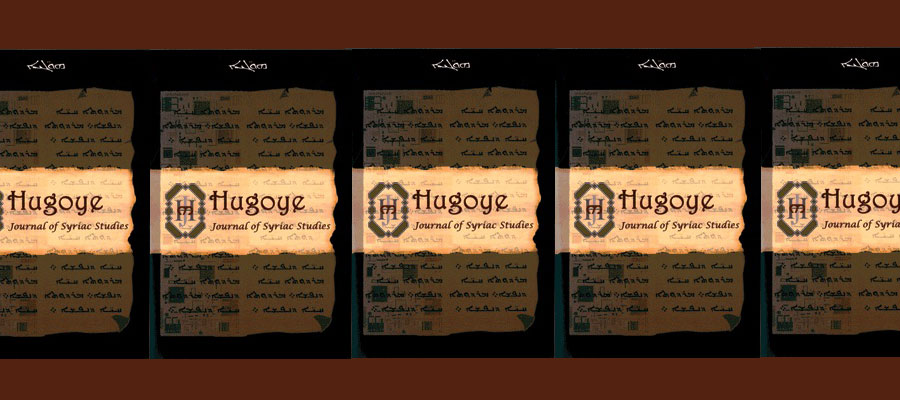Hugoye: Journal of Syriac Studies, volume 23, no. 1 (2020).
CONTENTS INCLUDE
Reclaiming Narsai’s Mēmrā of the Feast of the Victorious Cross: Unpublished Early Syriac Palimpsest Fragments from the British Library (BL, Add 17.137, no. 2)
Aaron Michael Butts, The Catholic University of America
In this article, I discuss the authorship of a mēmrā with the incipit ‘In the path of the divine mysteries, I have girded myself to walk’ (ܒܐܘܪܚܐ ܕܐܪ̈ܙܐ ܐܠܗ̈ܝܐ ܚܙܩܬ ܕܐܪܕܐ) that is found in four manuscripts that mostly contain mēmrē attributed to Narsai (d. ca. 500). Macomber read the heading of the mēmrā in question as mār(y) Ṣlibā zkā (ܡܪܝ ܨܠܝܒܐ ܙܟܐ), which he took to refer to the author of the homily: ‘an otherwise unknown Ṣlibazka’ in his words. Departing from Macomber and building upon a previous suggestion by Ibrahim, I argue here that the earliest recoverable archetype of this heading actually read ʿē(ʾ)dā daṣlibā zakkāyā ‘Feast of the victorious cross’ (ܥܐܕܐ ܕܨܠܝܒܐ ܙܟܝܐ ), which should be understood as the title of a homily implicitly attributed to Narsai. The change from an original title to a faux author started, I suggest, with a graphic error in which <ʿʾdʾ> (ܥܐܕܐ) was misread by a scribe as
Obsequies of My Lady Mary (I): Unpublished Early Syriac Palimpsest Fragments from the British Library (BL, Add 17.137, no. 2)
Christa Müller-Kessler, Friedrich-Schiller-Universität Jena
The Syriac palimpsest folios listed under Add 17.137, no. 2 in Wright’s Catalogue of the Syriac Manuscripts in the British Museum have been described as deriving from the Obsequies of My Lady Mary. This attribution has never been questioned afterwards. Although a specimen consisting of only one column of a single folio was published a few years ago, the remaining text on the folio and the other five have been left unedited. It was recently understood that under this sub shelfmark number two divergent manuscripts are hidden. One manuscript surviving only in two folios contains the Obsequies and is written in an elegant Estrangela script (ca. 5th cent.), while the other, in a much bolder script type, shows Jacob of Serugh’s Homily on the Presentation in the Temple (ca. 6th cent.), one of the few palimpsest and earliest text examples of this author. Only the folios with the Obsequies are edited here, which offer noteworthy textual additions and a selection of diverse variants that are not accounted for by the Christian Palestinian Aramaic and much later Ethiopic transmissions.
From Antony of Tagrit to the Arabic Version: The Syriac Technical Vocabulary of Rhetoric and the Migration of Words
Mara Nicosia, University of Naples ‘L’Orientale’
Rhetoric was part of the borrowed Greek educational system of the Enkyklios paideia, together with logic and grammar. However, the technical terminology had to be adapted, so the question is which strategies were used to create the vocabulary of Syriac rhetoric. This paper aims at analyzing some meaningful loanwords, adaptations, calques and native words used to build this specialized lexis. A manuscript containing the Syriac version of Aristotle’s Rhetoric was never found, and we need to rely upon other texts that dealt with this topic: Antony of Taġrit’s Books of Rhetoric, a part of Bar Šakko’s Book of dialogues and a part of Bar Hebraeus’s Cream of wisdom. If we wish to have a deeper appreciation of this vocabulary, however, we need to take into account the Arabic version of Aristotle’s Rhetoric, since it displays some interesting peculiarities that can help us in the reconstructive process of what the Syriac version might have looked like. A very useful tool would be the compilation of a database comparing the Syriac lexis found in the abovementioned texts with the ones used in the Greek and Arabic versions of Aristotle’s book: actually, this method already highlighted some surprising phenomena that will be presented in this paper, in order to show how trilingual comparison can be an important tool to shed some light on the translation movement of both texts and cultural patterns that started in Late Antiquity.
Field Notes on Syriac Manuscripts III: A Previously Unknown Philosophical Manuscript from Alqosh
Grigory Kessel, Austrian Academy of Sciences / University of Manchester, and Yury Arzhanov, Austrian Academy of Sciences
The article offers a description of the composite East Syriac manuscript preserved in Alqosh (Northern Iraq). Two originally independent parts of the manuscript contain works dealing for the most part with philosophy, logic, grammar and lexicography and were produced in 19th century Alqosh. Whereas the exemplar of one of these can be determined with certainty (British Library, India Office 9), that of the second part is more elusive. This previously unknown manuscript not only provides new textual evidence for a large number of texts, but is also of significant historical importance as a document attesting to the revival of interest in the study of philosophy and grammar in the Chaldean milieu during the modern period.
